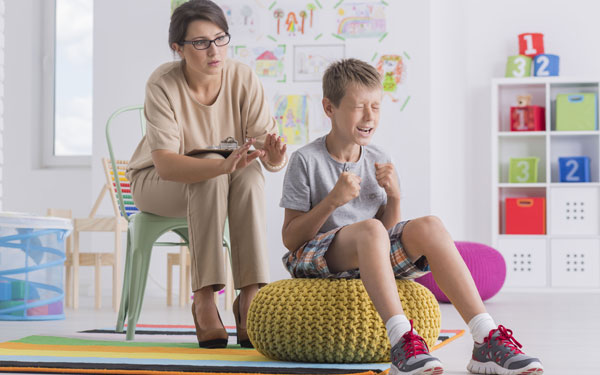
How Sensory Modulation Contributes to Behavior in Children
In today’s world of medicine and education, the tendency to label a child’s behavior as a “behavior disorder” or to file it in a diagnostic category is a common practice. As a result, the child’s parents shift back and forth from one professional opinion to the other, starting a therapy treatment for the child’s disorder only to let it go, while the child starts to feel more and more helpless and out of control, which can become evident in their behavior.
As a subtype of sensory processing disorder and from an occupational therapy perspective, sensory modulation is the ability of a person’s autonomic nervous system (ANS) to regulate the activity between the sympathetic (arousal) and parasympathetic (inhibition) systems, allowing them to increase or decrease activity so that the desired outcome of activity creates harmony in all functions of the central nervous system (Ayres 1979).
In sensory modulation disorder (SMD), a regulatory imbalance often causes difficulties in a child’s behavior while anxiety levels rise. The child often is labeled as “having behavior problems” and also is blamed for them, even though it is a developmental delay and a neurobiological condition.
Sensory modulation disorder has long-term impact on a child’s development. If a child has a developmental delay, whether visual, auditory or otherwise, sensory modulation often impacts how these different sensory systems register information in order to process them. It really supports the ‘entry point of information’. If there is a disorder in this function, it’s a disconnect between what’s coming in externally from the context of the environment and the person’s internal experience of that same environment. That alters what we call the adaptive response.
Understanding A Child’s Behavior
A child’s response to sensory input is dictated by their central nervous system. Each person has unique thresholds of response that cause a nerve cell or a system to activate. Children with a low threshold notice and respond to stimuli often, and their systems are frequently activated. Children with a high threshold miss stimuli that others notice and need stronger stimuli to activate.
The hallmark of sensory modulation is that the child does not have consistent performance. It depends on how they slept. It depends on what they ate. It depends on how their system is adapting. It depends on how many coping strategies are available to them at any given moment. It’s not willful behavior.
The Four Patterns of Self-Regulation
Self-regulation is a behavioral construct of Dunn’s Model of Sensory Processing. According to Dr. Dunn, people either have a passive strategy or an active strategy for reacting to things that happen around them. She sites these examples:
When a passive strategy for self-regulation intersects with an active strategy, four basic patterns of sensory processing emerge that involve the relationship among thresholds, self-regulation and sensory processing patterns:
Sensation Seeking – high thresholds with active self-regulation
- Enjoy sensory experiences and input
- Move more, hum during the day
- Jump up and down, rub hands together often
- May be distracted by new sensory experiences
- May have more difficulty completing tasks
- May lose track of daily life tasks
Sensation Avoiding – low thresholds with active self-regulation
- Notice things much more than others
- Like quiet environments, to be more isolated or alone
- Get anxious more quickly
- Withdraw from challenging environments
Sensory Sensitivity – low thresholds with passive self-regulation
- Detect sensory events more frequently
- Get distracted more easily
- Get upset by seemingly unnoticeable things
- Notice more details in life
- Notice changes in setting or moods more quickly
- Get interrupted from completing tasks
Low Registration – high threshold with passive self-regulation
- Miss more cues than others
- Fail to notice details
- May be more easy going
- Take no notice when called
- Drift away during activities
- Find it hard to get tasks completed in a timely manner
Self-regulation is the basis upon which we build all our functions. This is why we see so many kids wanting to be controlling. They are acting out of a subconscious need for self-protection. They want to control others externally so that they can feel in control internally.
For example, a child may continue to sit amidst other children during play and become irritable because of all the random sounds in the play area. It is a passive self-regulation strategy to remain in this noisy play area even when the child feels uncomfortable from all the sounds. At the other end of the continuum, persons utilize an active strategy … For example, the same child playing amidst other children would crawl to a quieter place when the sound got overwhelming. It is an active self-regulation strategy to adjust one’s position to get a more manageable amount of sensory input.

Link Between Childhood Trauma and Sensory Modulation Disorder
Chronic traumatic stress such as abuse and neglect creates changes in a child’s brain that trigger their fear response automatically, which is called a state of “hyperarousal.” Physiological changes during hyperarousal influence thinking, feeling and acting, which indicate a neurogenic response rather than a behavioral reaction.
You cannot treat sensory modulation through a behavior program. You are going to fail. The neurological system will have to be reset. We want kids to think and then do and then feel. Children with sensory modulation disorder feel first, then they do, then they think.
Some successful neurogenic treatments for sensory modulation disorder include programs that strengthen interoception and the awareness of self.
Interoception, one of the newest buzzwords in occupational therapy circles, allows people to “feel” internal organs and skin while providing a status report on the internal condition of the body. Interoception involves a variety of general, localized feelings such as pain, body temperature, itchiness, sexual arousal, hunger, thirst, heart rate, breathing rate, muscle tension, pleasant touch, sleepiness and bathroom urges as well as warmth or coldness, tickling or shivering, tension or relaxation, constriction or expansion, sinking or lifting, trembling or steadiness. These feelings are a key component of emotional experience and the basis for how people feel emotions. Often called “the eighth sensory system,” interoception can help a child calm down and self-regulate as a result of being more aware of the feelings within their bodies.
Interoception, combined with the awareness of self, form a social foundation for how people behave and interact with their surroundings and allow the development of a first-person perspective that connects thoughts, feelings, intentions and the body. When a child starts to understand themselves and develops a healthy self-awareness, only then can they move on to understanding others and the environment they live in.








Recent Comments